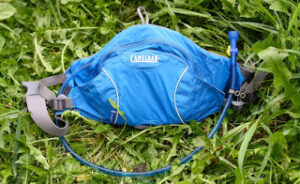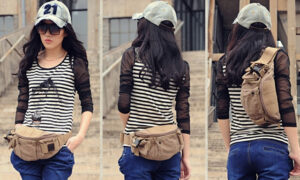“Are you a doctor?”
I had heard the same question a number of times that day. Finally I had worked out the reason. It was a day so hot the locals were bothered by the heat. I was using my three-litre Platypus bottle. The drinking tube projected from the top of my daysac and was clipped with the bite valve near my collar. Many of the locals had come to the conclusion that I was wearing a stethoscope, and must be a doctor!
Platypus are a company that makes flexible waterbottles similar to the better known Camelbacks. I’ll use “camelback” as a generic term for water bladders of this type.
Since their introduction camelbacks and similar designs have widespread use by both civilians and military. Watch footage of troops in Iraq or Afghanistan and you are likely to spot a drinking tube.

Most camelbacks are backpacks. They are either incorporated into packs, carried in packs or worn as packs. There are a number of situations where a military user may have to operate without a pack, even one as small as a three litre camelback. There may not be time to unpack a camelback from a larger pack. It is standard practice for soldiers to carry water in their belt order for such instances. Commonly this is in the form of one or two one-litre waterbottles. Such bottles are not without their disadvantages. Typically they are rigid and if the soldier falls upon one or rolls onto it he can injure himself. If the bottle is only partially filled the sloshing of the water may be audible and reveal the soldier’s position. Drinking from a bottle usually involves removing it from its pouch. Some designs have a mug that fits over the top of the bottle and this must be removed before the bottle can be removed from the pouch.
Suppose there was something like a camelback that could fit on a soldier’s belt order instead of waterbottles? Being a bladder there would be less airspace inside and sloshing noises would be reduced. Such a system would be compatible with a drinking tube and bite value. The wearer could drink whenever he needed to with minimum hassle. The bladder would have some give should the soldier fall on it or roll on it. Perhaps there would be a pressure release valve that would prevent the bladder bursting if it was severely compressed?


I did a little bit of searching and discovered there are bumbags that include water bladders. Cyclists and runners use them but military users seem oblivious to their potential. The designs I came across tended to be 1.5 litre capacity and were only available in non-tactical colours.


Today I tried another track. Two-litre capacity bladders are available. Some are sold on their own as a replacement part. If I acquire one I could then locate a bumbag or similar that could contain it. A bumbag seems like a likely carrier since they come with their own belt and quick release buckle. If necessary they can be worn suspended from a shoulder or hung from the neck, which may be more comfortable if sitting in a vehicle for a length of time.


Keep reading the blog for further progress with this project.